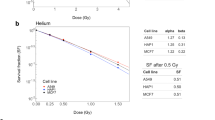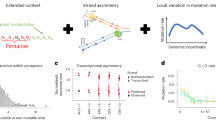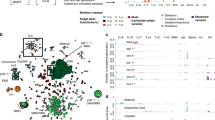Abstract
THAT X-ray induced, specific locus, germ-line mutation rates vary significantly in eukaryotes is generally known, but the factors that are responsible for such differences have not been assessed in detail. It was recently proposed1 for a variety of species that mutability is closely and simply related to total DNA per genome. This approach, however, has not stood the test of critical review2; in fact, even within one species (mouse) there are major differences between the rates for different genes, and even for different germ cells3–5. I have therefore taken a different approach by considering the radiobiology of the individual gene. The analysis leads to three major conclusions. (1) Mutation rates tend to be much lower than radiation theory predicts. (2) Selection and/or repair are major factors that determine the rates. (3) The mouse 7-locus test, which provides a principal data base for the standards of human radiation hygiene, may not provide adequate overall representation of the mutability of the mammalian genome, so more research is needed.
This is a preview of subscription content, access via your institution
Access options
Subscribe to this journal
Receive 51 print issues and online access
$199.00 per year
only $3.90 per issue
Buy this article
- Purchase on Springer Link
- Instant access to full article PDF
Prices may be subject to local taxes which are calculated during checkout
Similar content being viewed by others
References
Abrahamson, S., Bender, M. A., Conger, A. D., and Wolff, S., Nature, 245, 460–461 (1975).
Schalet, A. P., and Sankaranarayanan, K., Mutat. Res., 35, 341–370 (1976).
Russell, W. L., in Advances in Radiation Research Biology and Medicine (edit. by Duplan, J. F. and Chapiro, A.), 323–334 (Gordon and Breach, New York, 1973).
Russell, W. L., in Repair from Genetic Radiation Damage, (edit. by Sobels, F. H.), 205–217 (Pergamon, Oxford, 1963).
Kohn, H. I., and Melvold, R. W., Nature, 259, 209–210 (1916).
Lea, D. E., Actions of Radiations on Living Cells (Cambridge University Press, Cambridge, 1946).
Pollard, E. C., Guild, W. R., Hutchinson, F., and Setlow, R. B., Progress in Biophysics, 5 (edit. by Butler, J. A. V., and Randall, J. T.), 72–108 (Academic, New York, 1955).
Hutchinson, F., Science, 134, 533–538 (1961).
Dertinger, H., and Jung, H., Molecular Radiation Biology (Springer, New York, 1970).
Augustine, L. G., Brustad, T., and Mason, R., Adv. Radiat. Biol., 1 (edit. by Augenstein, L. G., Mason, R., and Quastler, H.) 227–266 (Academic, New York, 1964).
Lyon, M. F., and Morris, T., Mutat. Res., 8, 191–198 (1969).
Author information
Authors and Affiliations
Rights and permissions
About this article
Cite this article
KOHN, H. X-ray induced mutations, DNA and target theory. Nature 263, 766–767 (1976). https://doi.org/10.1038/263766a0
Received:
Accepted:
Issue Date:
DOI: https://doi.org/10.1038/263766a0
Comments
By submitting a comment you agree to abide by our Terms and Community Guidelines. If you find something abusive or that does not comply with our terms or guidelines please flag it as inappropriate.



